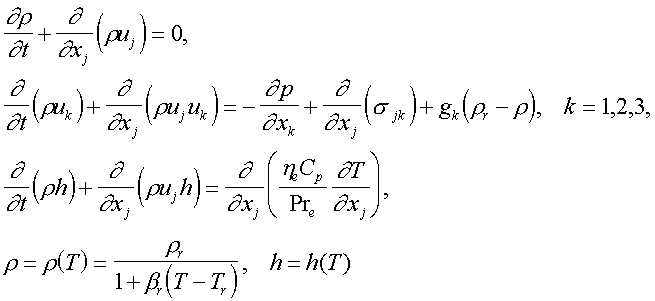
Школа-семинар по численным методам механики вязкой жидкости
A NUMERICAL STUDY OF NATURAL AND MIXED CONVECTION HEAT TRANSFER IN NON-RECTANGULAR GEOMETRIES
L.P. Kamenshchikov 1, A.A. Dekterev 2
1 Institute of Computational Modelling SB RAS, (660036, Krasnoyarsk, Russia) (*)
E-mail: lk@cc.krascience.rssi.ru
2
Siberian Branch Institute for Fire Protection (660049, Krasnoyarsk, Russia)Natural and mixed convection in enclosures is present in many technological applications such as: heat exchanges, electronic devices, fire and ventilation in buildings, etc. Numerical studies of such phenomena have mainly been devoted to describing flows in rectangular geometries.
The time-averaged governing equations of the fluid flow (continuity, momentum, energy, equation of state) may be written as [1]:![]()

where ![]() is a representative temperature,
is a representative temperature, ![]() is viscosity, and
is viscosity, and ![]() . The other notations are standard. This model is more general than known Boussinesq approximation in which the influence of variable density appears only in the buoyancy term.
. The other notations are standard. This model is more general than known Boussinesq approximation in which the influence of variable density appears only in the buoyancy term.
In many practical problems the buoyancy-influenced flows are usually surrounded by complicated-shaped boundaries, which makes it difficult to apply numerical methods based on Cartesian coordinates. In order to overcome this problem, a boundary-fitted grid is used in the present study, since treatment of boundary conditions is simplified.
Independent variables are transformed while the velocity components are retained as Cartesian components. The transformed equations are recorded in the discretic form. The solution of the finite differences equations is obtained iteratively using a well known pressure-velocity correction algorithm SIMPLE-C. The convection terms are treated by the QUICK scheme [2] in order to reduce the numerical diffusion. The unsteady state character of the equations is treated by using a fully-implicit scheme. Two and three-dimensional non-orthogonal curvilinear grids are generated by using Laplace equation.
In order to verify solution algorithm, we have compared our numerical results with the exact velocity and temperature profiles of a fully developed one-dimensional flow which exists in the mid-region of the high vertical slot [3].
Also 2-D natural convection in a square and parallelogram-shaped enclosures have been studied. The enclosure has an isothermal hot wall at temperature ![]() and an isothermal cold wall at temperature
and an isothermal cold wall at temperature ![]() , both inclined at an angle
, both inclined at an angle ![]() with respect to horizon. The horizontal walls are adiabatic.
with respect to horizon. The horizontal walls are adiabatic. ![]() since the most likely applications are for air. In figures below isolines of temperature are plotted. In this pictures
since the most likely applications are for air. In figures below isolines of temperature are plotted. In this pictures ![]()
![]()
![]()
![]()
![]()
![]()
![]()
An examples of the laminar and turbulent natural-convection flow in differentially heated trapezoidal enclosures for Rayleigh number ![]() are presented. The standard
are presented. The standard ![]() model is used to describe turbulence. The computed results are compared with the reported data of other authors [4] and [5]. Example of calculation of a smoke motion in a three-dimensional model high-altitude building also is considered. In all cases reliable results are received.
model is used to describe turbulence. The computed results are compared with the reported data of other authors [4] and [5]. Example of calculation of a smoke motion in a three-dimensional model high-altitude building also is considered. In all cases reliable results are received.
|
|
|
|
|
|
|
|
|
|
|
Figs. Isotherm and velocity fields in different enclosures. |
|
||
This work was supported by Russian Foundation of Basic Research (grant ? 97-01-00770).
REFERENCES
1. Chin-Hsien Li, R. Glovinski. Int. J. Num Meth. Fluids, 23, 77-103 (1996).
2. B.P. Leonard. Comp. Meth. Appl. Eng., 19, 59-98 (1979)
3. D.R. Chenoweth, S. Paolucci, Phys. Fluids, 28, 2365-2374 (1985)
4. M. Peric, Numerical Heat Transfer, 24, 213-219 (1993)